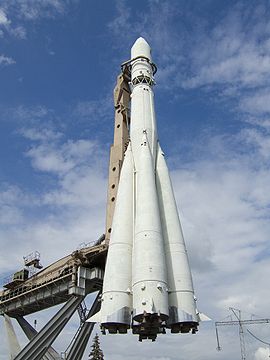Vostok (rocket family)

Vostok 8K72K rocket on display in Moscow at the All Russia Exhibition Centre
|
|
| Function | Carrier rocket |
|---|---|
| Manufacturer | RKK Energia |
| Country of origin | USSR |
| Size | |
| Stages | 2 |
| Capacity | |
| Payload to LEO | 4,725 kilograms (10,417 lb) |
| Associated rockets | |
| Family | R-7 |
| Comparable |
Atlas Titan |
| Launch history | |
| Status | Retired |
| Launch sites |
Baikonur: LC-1/5, 31/6 Plesetsk: LC-41/1, 43/3, 43/4 |
| Total launches | Vostok-L: 4 Vostok-K: 13 Vostok-2: 45 Vostok-2M: 94 Soyuz/Vostok: 2 |
| Successes | Vostok-L: 3 Vostok-K: 11 Vostok-2: 40 Vostok-2M: 92 Soyuz/Vostok: 2 |
| Failures | Vostok-L: 1 Vostok-K: 2 Vostok-2: 5 Vostok-2M: 2 |
| First flight | 15 May 1960 (Vostok-L) |
| Last flight | 29 August 1991 (Vostok-2M) |
| Notable payloads |
Vostok Zenit Meteor |
| Boosters (Vostok-K) | |
| No. boosters | 4 |
| Engines | 1 RD-107-8D74-1959 |
| Thrust | 970.86 kN |
| Total thrust | 3,883.4 kN |
| Burn time | 118 seconds |
| Fuel | RP-1/LOX |
| First stage (Vostok-K) | |
| Engines | 1 RD-108-8D75-1959 |
| Thrust | 912 kN |
| Burn time | 301 seconds |
| Fuel | RP-1/LOX |
| Second stage (Vostok-K) | |
| Engines | 1 RD-0109 |
| Thrust | 54.5 kN |
| Burn time | 365 seconds |
| Fuel | RP-1/LOX |
Vostok (Russian Восток, translated as "East") was a family of rockets derived from the Soviet R-7 Semyorka ICBM designed for the human spaceflight programme. This family of rockets launched the first artificial satellite (Sputnik 1) and the first manned spacecraft (Vostok) in human history. It was a subset of the R-7 family of rockets.
On March 18, 1980 a Vostok-2M rocket exploded on its launch pad at Plesetsk during a fueling operation, killing 48 people. An investigation into a similar – but avoided – accident revealed that the substitution of lead-based for tin-based solder in hydrogen peroxide filters allowed the breakdown of the H2O2, thus causing the resultant explosion.
The major versions of the rocket were:
Vostok rocket
Vostok rocket
...
Wikipedia
